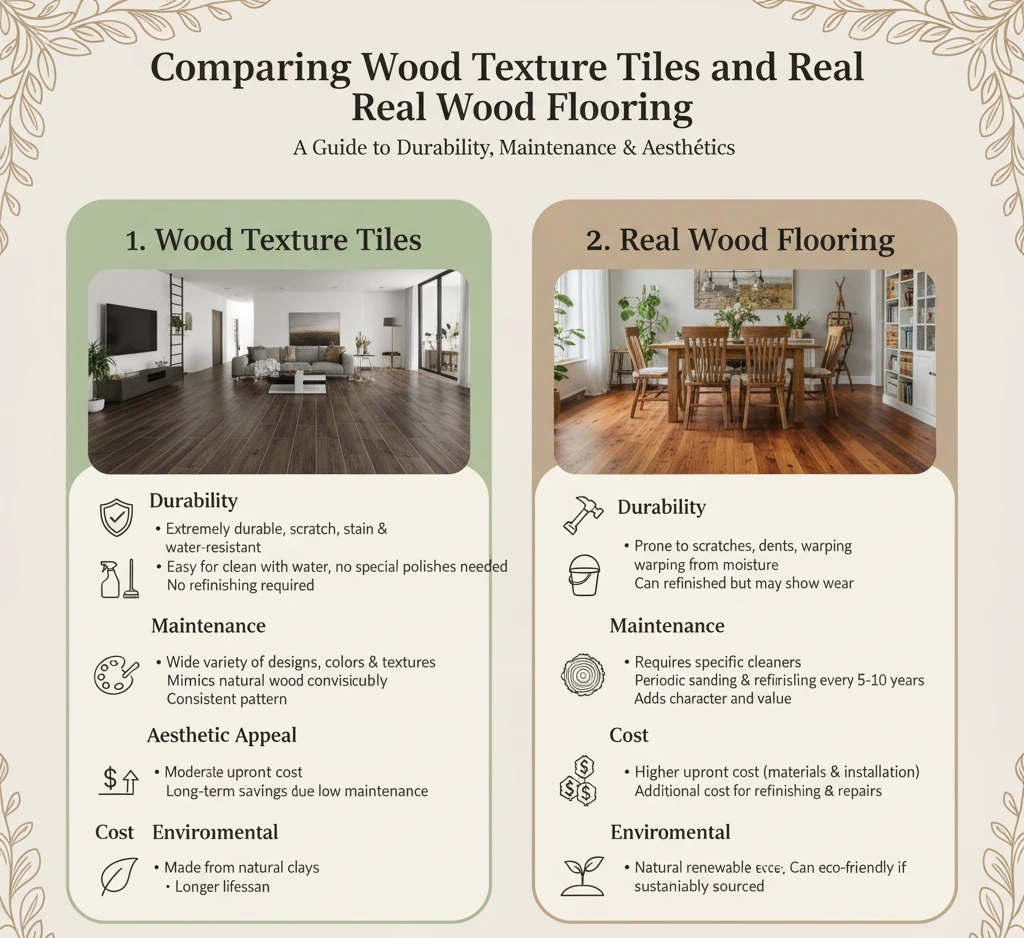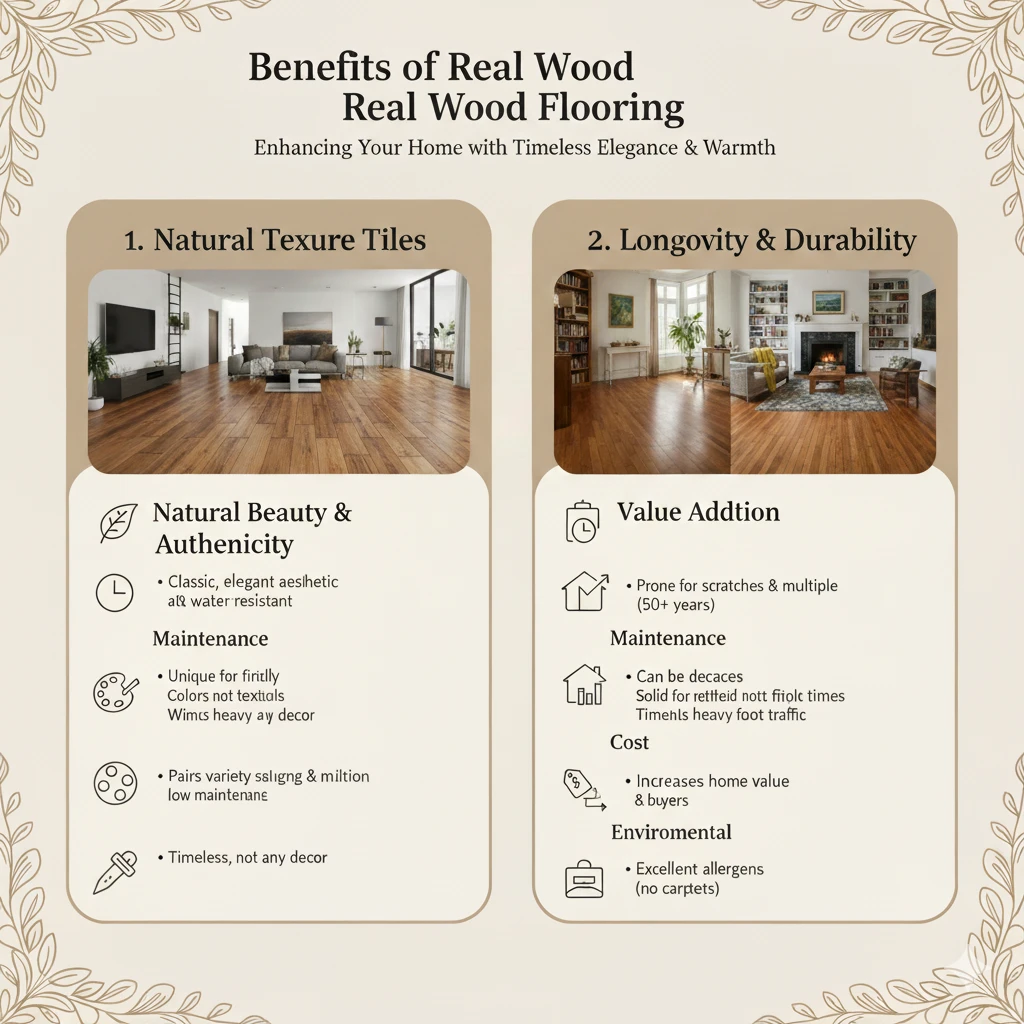5 November, 2025

Introduction
Selecting the perfect flooring is one of the most critical decisions for any home renovation or new construction project because it affects the overall aesthetics, durability, comfort, and value of your property. The natural charm of wood has always attracted homeowners due to its timeless elegance, warmth, and versatility, but with modern innovations, many are considering wood texture tiles as an alternative that offers the look and feel of wood without the limitations of natural timber.
Real wood flooring provides authentic character, with each plank showcasing unique grain patterns, subtle color variations, and natural knots that add depth and personality to your interiors. On the other hand, wood texture tiles are engineered to replicate these qualities with remarkable accuracy, often offering additional benefits like moisture resistance, easy maintenance, and longer-lasting durability, making them a compelling choice for contemporary homes.
This blog explores the differences, benefits, drawbacks, and practical considerations of both flooring options to help homeowners, interior designers, and architects make an informed decision tailored to their specific needs.
What Are Wood Texture Tiles?
Wood texture tiles are specially manufactured ceramic or porcelain tiles that are designed to mimic the natural look, grain, and texture of wood, making them an ideal alternative for homeowners who want the aesthetic appeal of wood without its maintenance challenges.
Some key features include:
-
Variety of finishes and grains: These tiles come in matte, glossy, or textured finishes that closely resemble hardwood surfaces like oak, walnut, or cherry. Advanced manufacturing techniques allow for tileable texture wood patterns that can seamlessly cover large floors without visible repetition, giving the illusion of a continuous wood surface.
-
Durability in challenging conditions: Unlike real wood, wood texture tiles are highly resistant to scratches, stains, moisture, and heat, making them suitable for kitchens, bathrooms, laundry rooms, and even outdoor spaces where natural wood would warp or deteriorate over time.
-
Versatility in design applications: Beyond flooring, these tiles can be used as wood texture wall tiles, accent panels, or even exterior cladding. They come in a wide range of plank sizes, colors, and patterns to match any interior theme, from rustic farmhouse to sleek modern spaces.
For homeowners looking to enjoy the beauty of wood grain floor tile without the headaches of regular maintenance, these tiles offer a practical yet visually appealing solution.
What Is Real Wood Flooring?
Real wood flooring consists of solid hardwood planks or engineered wood, providing natural warmth, character, and long-term value to any space.
-
Solid wood flooring: Made entirely from hardwood species such as white oak, maple, or teak. Each plank is unique in its grain, texture, and color, allowing for subtle variations that create a rich, dynamic floor surface. Solid wood floors can be sanded and refinished multiple times, extending their lifespan by decades when properly maintained.
-
Engineered wood flooring: Features a thin layer of real hardwood on top of a stable plywood or high-density fiberboard base. Engineered wood is less prone to warping and swelling in humid environments, making it more suitable for areas where moisture is a concern compared to solid wood.
The main advantages of real wood flooring lie in its natural authenticity, its ability to increase home value, and the sense of warmth it brings to living spaces, creating an inviting and elegant atmosphere.
Comparing Wood Texture Tiles and Real Wood Flooring

Durability
-
Wood texture tiles are incredibly durable, designed to withstand heavy foot traffic, accidental spills, and daily wear and tear without losing their visual appeal. For example, ceramic wood tile texture can resist stains, scratches, and water damage, making them ideal for wood grain tiles bathroom or kitchen areas where traditional wood would deteriorate.
-
Real wood flooring, while durable, is naturally softer and more prone to dents, scratches, and moisture-related damage. High-quality hardwood like white oak solid wood flooring can last for decades, but requires careful maintenance to prevent warping, water stains, and fading from sunlight exposure.
Maintenance
-
Wood texture tiles require minimal upkeep. Routine sweeping and occasional mopping are sufficient to keep the surface clean. There’s no need for refinishing, sealing, or special treatments, making them an excellent choice for busy households or commercial spaces where low maintenance is crucial.
-
Real wood flooring demands more care. Homeowners must clean regularly using appropriate wood cleaners, avoid standing water, and periodically reseal or refinish the surface to maintain its natural beauty and prevent damage. In bathrooms or kitchens, water spills must be cleaned immediately to avoid warping or mold growth.
Aesthetic Appeal
-
Wood texture tiles provide a consistent, uniform appearance that can replicate various wood grains and colors. From ceramic tiles wooden texture for rustic charm to wood floor tile texture for contemporary elegance, these tiles can be customized to suit specific design preferences. Some tiles even feature embossed surfaces that feel like real wood underfoot, enhancing the sensory experience.
-
Real wood flooring offers an unmatched natural charm. Each plank carries its unique story, with variations in grain, texture, and color adding depth, warmth, and authenticity to a room. The natural evolution of wood over time can enhance the character of your home, making each floor unique.
Cost
-
Wood texture tiles are generally more cost-effective than real wood, both in upfront purchase and long-term maintenance. Prices vary depending on quality, design, and brand, but even high-end porcelain wood grain ceramic tiles are usually more affordable than premium hardwood planks.
-
Real wood flooring tends to have a higher upfront cost, especially for high-quality species like white oak, walnut, or cherry. Additionally, periodic maintenance, refinishing, and potential repairs add to the total cost over the years.
Environmental Considerations
-
Wood texture tiles can be made using recycled materials and reduce the demand for natural timber, supporting sustainable practices while providing the aesthetic appeal of wood.
-
Real wood flooring, although renewable when sourced responsibly, has a higher environmental footprint due to logging, transportation, and processing. Choosing certified sustainable wood helps mitigate environmental impact.
Quick Comparison: Wood Texture Tiles vs Real Wood Flooring
| Feature | Wood Texture Tiles | Real Wood Flooring |
|---|---|---|
| Material | Ceramic or porcelain designed to mimic wood grain | Solid hardwood or engineered wood |
| Durability | Highly resistant to scratches, stains, and moisture | Durable but prone to scratches, dents, and moisture damage |
| Maintenance | Low – sweeping and occasional mopping | High – regular cleaning, sealing, refinishing required |
| Aesthetic Options | Wide range of colors, grains, and tileable texture wood patterns | Unique natural variations, warm tones, and authentic wood feel |
| Cost | Generally more affordable, low long-term maintenance cost | Higher upfront cost, maintenance adds to total cost |
| Best Use | Bathrooms, kitchens, outdoor spaces, walls, high-traffic areas | Living rooms, bedrooms, areas where authenticity and warmth are priority |
Where Can Wood Texture Tiles Be Used?
Wood texture tiles are extremely versatile and can be applied in multiple areas:
-
Living rooms and bedrooms: Provide a warm, inviting atmosphere with wood floor tile texture that mimics hardwood. Ideal for families or spaces where durability is needed.
-
Kitchens and bathrooms: Moisture-resistant tiles like wood grain tiles bathroom prevent warping and staining, making them ideal for wet or high-traffic areas.
-
Outdoor spaces: Certain exterior wood tile texture tiles can withstand sunlight, rain, and temperature fluctuations, making them perfect for patios, balconies, and poolside decks.
-
Wall applications: Wood texture wall tiles create visually striking accent walls, fireplaces, or feature panels that bring the warmth of wood into vertical spaces without the maintenance challenges of real wood.
Benefits of Real Wood Flooring

While wood texture tiles have numerous advantages, real wood flooring remains a preferred choice for many:
-
Natural beauty and authenticity: Each plank is unique, with variations in grain, color, and texture that cannot be perfectly replicated.
-
Longevity and durability: Properly maintained hardwood can last 50 years or more, making it a long-term investment for your home.
-
Value addition: Homes with hardwood flooring often enjoy higher resale value due to their premium look and enduring appeal.
-
Comfort and warmth: Wood floors feel softer underfoot compared to tiles and have natural insulating properties, helping regulate temperature and providing comfort.
How to Choose Between Wood Texture Tiles and Real Wood
Consider the following factors to make the best decision:
-
Budget: If you want an elegant wood look without spending excessively, wood texture tiles are cost-effective both upfront and over time.
-
Environment: Moisture-prone areas such as bathrooms, kitchens, or outdoor spaces are better suited for tiles, whereas dry living areas can accommodate real wood.
-
Maintenance preference: For those seeking low-maintenance options, tiles are ideal. If you enjoy the upkeep and authenticity of real wood, hardwood floors are a rewarding choice.
-
Aesthetic priorities: Decide if you prefer the uniform patterns and variety of wood texture tiles or the natural, evolving beauty of real wood flooring.
Alaska Surfaces: Premium Tile Manufacturer & Exporter
When it comes to high-quality wood texture tiles, Alaska Surfaces stands out as a leading manufacturer and exporter in India. They specialize in offering a wide variety of wood grain tiles in different finishes, colors, and sizes.
-
Product Variety: From matte and glossy finishes to textured planks, Alaska Surfaces provides solutions suitable for indoor floors, walls, and outdoor applications.
-
Premium Quality: Each tile is designed for durability, moisture resistance, and aesthetic excellence, ensuring long-lasting beauty in any space.
-
Customization: Available in multiple sizes and designs to match diverse architectural and interior needs.
-
Export Excellence: Trusted by clients globally for providing wood texture tile flooring that meets international standards in both design and quality.
Whether you’re designing a cozy living room, a moisture-prone bathroom, or a commercial space requiring wood grain ceramic tile, Alaska Surfaces offers premium solutions that combine beauty, durability, and flexibility.
FAQs
1. Are wood texture tiles suitable for bathrooms?
Yes, these tiles are highly moisture-resistant and ideal for wet areas like bathrooms and kitchens, offering the look of wood without water damage concerns.
2. Can wood texture tiles be used outdoors?
Yes, many exterior wood tile texture options are designed to withstand outdoor elements, including sunlight, rain, and temperature fluctuations.
3. How should I maintain real wood flooring?
Regular cleaning with appropriate wood-safe products, prompt attention to spills, and periodic refinishing or sealing are necessary to maintain its appearance and longevity.
4. Do wood texture tiles feel like real wood?
High-quality tiles with embossed textures replicate the tactile feel of wood, providing a realistic underfoot experience that closely mimics natural hardwood.
5. Which option is more environmentally sustainable?
Wood texture tiles generally have a lower environmental impact due to the reduced demand for timber and the potential use of recycled materials, whereas responsibly sourced hardwood remains a sustainable, yet higher-impact, option.
Conclusion
Both wood texture tile flooring and real wood flooring offer unique benefits:
-
Wood texture tiles: Ideal for moisture-prone areas, low maintenance, cost-effectiveness, and design versatility. They are available in a wide range of sizes, grains, and textures, making it easier to achieve a specific design vision.
-
Real wood flooring: Offers natural warmth, authenticity, long-term value, and a premium aesthetic that enhances home interiors. Properly maintained hardwood can last for decades, creating a timeless, elegant environment.
By considering factors such as durability, aesthetics, maintenance, budget, and sustainability, you can confidently choose the flooring option that aligns with your home’s functional and design needs